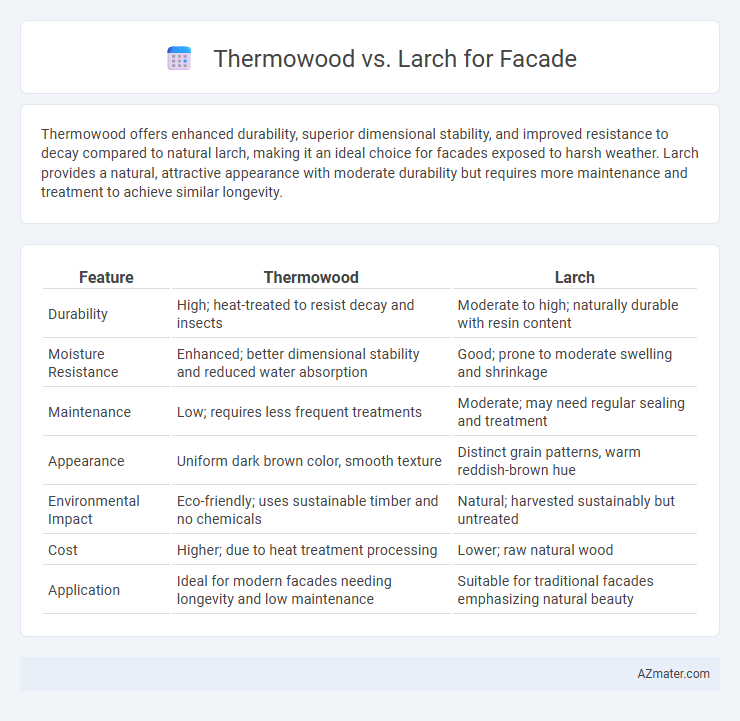Thermowood offers enhanced durability, superior dimensional stability, and improved resistance to decay compared to natural larch, making it an ideal choice for facades exposed to harsh weather. Larch provides a natural, attractive appearance with moderate durability but requires more maintenance and treatment to achieve similar longevity.
Table of Comparison
| Feature | Thermowood | Larch |
|---|---|---|
| Durability | High; heat-treated to resist decay and insects | Moderate to high; naturally durable with resin content |
| Moisture Resistance | Enhanced; better dimensional stability and reduced water absorption | Good; prone to moderate swelling and shrinkage |
| Maintenance | Low; requires less frequent treatments | Moderate; may need regular sealing and treatment |
| Appearance | Uniform dark brown color, smooth texture | Distinct grain patterns, warm reddish-brown hue |
| Environmental Impact | Eco-friendly; uses sustainable timber and no chemicals | Natural; harvested sustainably but untreated |
| Cost | Higher; due to heat treatment processing | Lower; raw natural wood |
| Application | Ideal for modern facades needing longevity and low maintenance | Suitable for traditional facades emphasizing natural beauty |
Introduction to Thermowood and Larch for Facades
Thermowood is a heat-treated softwood that offers enhanced durability, dimensional stability, and resistance to decay, making it an excellent choice for facades exposed to harsh weather conditions. Larch, a naturally durable hardwood, is known for its dense grain and high resin content, which provides natural protection against moisture and insects, suitable for long-lasting exterior cladding. Both Thermowood and Larch provide sustainable options for facade materials, with Thermowood offering improved performance through modification and Larch delivering inherent toughness and aesthetic appeal.
Key Properties of Thermowood
Thermowood offers exceptional durability and stability for facades due to its thermal modification process, which enhances resistance to moisture, decay, and insects without chemical additives. Compared to larch, Thermowood has reduced equilibrium moisture content, resulting in less warping and swelling, making it ideal for outdoor cladding. Its improved dimensional stability and eco-friendly profile make Thermowood a superior choice for long-lasting, low-maintenance facade solutions.
Key Properties of Larch Wood
Larch wood boasts exceptional durability and natural resistance to rot and decay, making it a preferred choice for facades exposed to harsh weather conditions. Its dense grain structure enhances strength and stability, providing long-lasting performance without extensive maintenance. Larch also offers a warm, reddish-brown hue that ages gracefully, creating an aesthetically pleasing and resilient cladding option compared to thermally modified wood like Thermowood.
Durability and Weather Resistance Comparison
Thermowood offers superior durability and weather resistance compared to Larch due to its heat-treated process, which reduces moisture absorption and enhances dimensional stability. Larch naturally contains high resin content, providing good resistance to decay, but it is more prone to swelling and warping under extreme weather conditions. For facade applications, Thermowood's enhanced stability and resistance to fungal decay make it a more reliable choice for long-term exposure to varied climates.
Aesthetic Differences: Appearance and Color
Thermowood facades exhibit a uniform, rich brown tone that deepens over time, offering a smooth, matte finish with minimal grain visibility due to the heat treatment process. Larch wood showcases natural variation with warm golden hues and pronounced knots and grain patterns, providing a more rustic and textured appearance. Choosing between Thermowood and Larch depends on whether a sleek, consistent look or a vibrant, natural aesthetic is desired for the facade.
Environmental Impact and Sustainability
Thermowood is produced through controlled heat treatment, significantly reducing its moisture content and increasing durability without chemical additives, making it an eco-friendly choice with a smaller carbon footprint compared to treatments involving synthetic preservatives. Larch wood, a naturally dense and resin-rich softwood, offers longevity and resistance to decay but typically requires more frequent maintenance and treatment, which can introduce additional environmental impacts over its lifecycle. Selecting Thermowood for facades supports sustainability goals by enhancing durability and reducing the need for chemical treatments, whereas larch's natural properties provide a renewable option but may involve higher ecological costs due to ongoing preservation needs.
Installation and Maintenance Requirements
Thermowood offers enhanced dimensional stability and resistance to moisture, which reduces warping and simplifies installation compared to untreated Larch. Larch requires careful acclimatization and more frequent sealing to prevent cracking and decay, increasing maintenance demands. Choosing Thermowood minimizes long-term upkeep while ensuring a durable, aesthetically consistent facade.
Cost Analysis: Thermowood vs Larch
Thermowood typically costs 20-30% more than Larch due to the additional heat treatment process that enhances durability and dimensional stability. While Larch offers a lower upfront price, it may require more frequent maintenance and replacement, increasing long-term expenses. Evaluating total cost of ownership shows Thermowood provides better value through reduced maintenance and extended lifespan.
Common Applications and Case Studies
Thermowood and Larch are popular choices for facade cladding due to their durability and aesthetic appeal, with Thermowood often preferred for its enhanced resistance to moisture and dimensional stability. Common applications include residential facades, commercial building exteriors, and public infrastructure where weather resistance and longevity are critical. Case studies highlight Thermowood's use in Scandinavian architecture for sustainable, low-maintenance facades, while Larch is frequently chosen for rustic, natural finishes in alpine and coastal projects.
Choosing the Right Wood for Your Facade
Thermowood and larch both offer excellent durability and natural resistance for facade applications, but Thermowood provides enhanced dimensional stability and improved decay resistance through heat treatment, making it ideal for harsh weather conditions. Larch, known for its rich grain and natural resin content, delivers a rustic aesthetic with good mechanical strength but may require more maintenance over time. Choosing the right wood depends on balancing factors like climate exposure, desired appearance, longevity, and maintenance preferences to ensure optimal facade performance.

Infographic: Thermowood vs Larch for Facade
 azmater.com
azmater.com